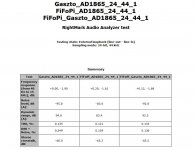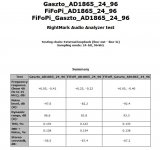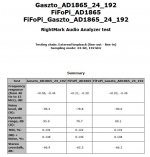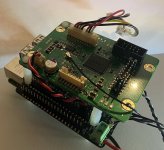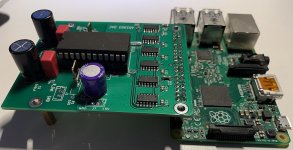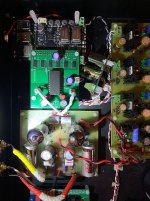Maybe I read something wrong.
Fundamental is -35dB on your fgure.
3rd harmonics is -135dB, so relative H3 is -100dB, or 0.001%.
Your FFT shows a lower number.
So maybe something not quite right with the FFT software ?
Or too close to noise to be accurate ?
So maybe you can raise the output back to 0dB fundamental by using a large Riv ?
Patrick
Fundamental is -35dB on your fgure.
3rd harmonics is -135dB, so relative H3 is -100dB, or 0.001%.
Your FFT shows a lower number.
So maybe something not quite right with the FFT software ?
Or too close to noise to be accurate ?
So maybe you can raise the output back to 0dB fundamental by using a large Riv ?
Patrick
That's very possible, and very likely. For that one I was just looking at the graphic and its very possible I fudged something on the scale. I'll take another look soon. Good catch!
@sworder84 asked BOM for PSU-2 from stocked components, here is one with a few compromises:
https://www.mouser.com/ProjectManager/ProjectDetail.aspx?AccessID=e52ebb6e0a
https://www.mouser.com/ProjectManager/ProjectDetail.aspx?AccessID=e52ebb6e0a
yeah I have a pending at Mouser since several month and some parts not avaliable till december of this year !
But it is ok, too much DACs, not enough ears yet!
But it is ok, too much DACs, not enough ears yet!
After a month or so of great performance my DAC has developed a random clicking/popping when there is no music playing, when playing it's fine. Swapped the SPDIF I2S board for another I built and its the same. So I am guessing the issue is on the DAC board.
Before I swap it for a different board (I built 2) anyone have any ideas where I should look?
Before I swap it for a different board (I built 2) anyone have any ideas where I should look?
First. Check your regs and the one of i2s as well. Could be the source as well. What happen if i2s source is switched off ? Clicks yet?
Thanks. Source disconnected makes no difference, same issue with coax or optical input selected.First. Check your regs and the one of i2s as well. Could be the source as well. What happen if i2s source is switched off ? Clicks yet?
I swapped the whole I2S board and have the same issue. I may try disconnecting the board completely and see
Power supply seems to be OK, although I'll check it fully with my scope at some point.
I have always had an occasional click/pop when the input source changes bit rate too, but not all the time.
@flak monkey Does it happen when you disconnect the I2S wires (even the selector will be disconnected) ?
Or is it the same with another preamp/amplifier (or in headphones?)
Or is it the same with another preamp/amplifier (or in headphones?)
Last edited:
Hi, I want to ask who you have on board AD1862 NOS instead of WIMAIt took long time.finally almost finished.
I am not confident with ground connection
so I would like to ask someone to check.
+-12V,+-5V is ok.
Rcore SCN connected to chaiss.
230V wire cut.
Star ground - cl60 - chaiss.
PSU2 center ground to star ground.
DAC 3 ground to star ground.
Film Capacitors 0.1uF 100 Volts 5%, there COG + polystyrene (PS) ar?
What does it sound like, what are the meanings?
Hi gaszto,This is what I used with AD1865. Disregard the first part of the circuit, use only the components what are in the red rectangle. B+ is 225V
I used 1W AN Non Magnetic Tantallum resistors, with V-Cap Odam coupling CAP. Sounds very sweet.
But using a transformer between a DAC chip and the tube stage is a gamechanger. 🙂
Thanks for sharing your experience. I want to use the 6n23p SRPP you applied to the AD1862. Can you share the gerber file?
Hi ewa777.
I have not compared with Wima and no measurement so I don't know what is better build. Only I can say this is really good DAC in my system.
I used Panasonic echu because from good reviews and cheaper than Wima here.
It was difficult to solder and I am not sure I could soldered right
Polystyrene cap have better reviews.I found copper film polystyrene cap but I am thinking that probably echu was good choice for more close to PCB low noise or inductance.
4.7uf pml cap I choose without comparison.
Polymer hybrid cap 47uf was better than nichicon gold tune or nippon-chemicon kzh.
But 100uf at output,I didn't like polymer so I choose Nippon-chemicon.
I have not compared with Wima and no measurement so I don't know what is better build. Only I can say this is really good DAC in my system.
I used Panasonic echu because from good reviews and cheaper than Wima here.
It was difficult to solder and I am not sure I could soldered right
Polystyrene cap have better reviews.I found copper film polystyrene cap but I am thinking that probably echu was good choice for more close to PCB low noise or inductance.
4.7uf pml cap I choose without comparison.
Polymer hybrid cap 47uf was better than nichicon gold tune or nippon-chemicon kzh.
But 100uf at output,I didn't like polymer so I choose Nippon-chemicon.
Guys, I've finished the FiFoPi AD1865 DAC.Maybe I can answer a week later. Currently I’m using RPi with JLSounds, but I’ve already bought FiFoPi, and it is on the way. But anyone else has comparison of the two platforms, pleas share experience 😀
My preferences are the folloing:
1. Raspberry Pi4, USB2 port ->JLSounds card ->AD1865 DAC (JLSounds card connected directly to AD1865) [measurement: Gaszto_AD1865_24_xxx]
2. Raspberry Pi4, FiFoPi -> AD1865 DAC with shift registers [measurement: FiFoPi_Gaszto_AD1865_24_xxx]
3. Raspberry Pi4, FiFoPi -> I2sToPcm card -> AD1865 DAC [measurement: FiFoPi_AD1865_24_xxx]
After I put together the FiFoPi with I2sToPcm card, the sound was dull, less stereo image, far away from my first setup.
The second (my pcb with shift registers according to Miro's design) configuration is almost as good as the first. Now I'll start fine tuning the system, changing the stock clock on the FiFoPi etc. I hope at the end I'll have as good DAC as the first configuration, but more compact.
Summarize, If somebody have JLSounds card according to my experiences and measurements, the stock FiFoPi is not an improvement. Ian mentioned for best result recommended to change the stock clock and using LiFePo power supply.
Attachments
@gaszto I told you guys, R-2Rs are not as sensitive to jitter as delta-sigma are, and the sound experience is not only about very low jitter guaranteed from reclockers 🤣 From my experience, it is important that the LRCK remains as clean as possible (this does not apply to some chips (PCM1702/4) that latch through BCK) 🤔
Miro,@gaszto I told you guys, R-2Rs are not as sensitive to jitter as delta-sigma are, and the sound experience is not only about very low jitter guaranteed from reclockers 🤣 From my experience, it is important that the LRCK remains as clean as possible (this does not apply to some chips (PCM1702/4) that latch through BCK) 🤔
I agree with you. It is a special situation, because I’m using RPi as audio player, and RPi is not designed for audio. I2S signal of the GPIO port is not too good. A lots of noises coming from it. A few years ago I designed a DAC HAT with TDA1543 chip, I have used Isolator IC to make “clean” I2S signal.
That is the reason why I bought FiFoPi. The isolated “clean” I2S (LRCK) is necessary as you mentioned. Reclocking is just extra feature in this case.
For raspberry it is the best to use USB card to do the I2S job 👍
1. Raspberry Pi4, USB2 port ->JLSounds card ->AD1865 DAC (JLSounds card connected directly to AD1865)
Can you test this?
Raspberry Pi4, USB2 port ->JLSounds card ->AD1865 DAC with shift registers
And further test very cheap USB-I2S - PCM2706 with raspberry?
1. Raspberry Pi4, USB2 port ->JLSounds card ->AD1865 DAC (JLSounds card connected directly to AD1865)
Can you test this?
Raspberry Pi4, USB2 port ->JLSounds card ->AD1865 DAC with shift registers
And further test very cheap USB-I2S - PCM2706 with raspberry?
Hi gaszto,Miro,
I agree with you. It is a special situation, because I’m using RPi as audio player, and RPi is not designed for audio. I2S signal of the GPIO port is not too good. A lots of noises coming from it. A few years ago I designed a DAC HAT with TDA1543 chip, I have used Isolator IC to make “clean” I2S signal.
That is the reason why I bought FiFoPi. The isolated “clean” I2S (LRCK) is necessary as you mentioned. Reclocking is just extra feature in this case.
you are not alone on this issue, I found JLsound is good to Miro1360 dac directly, as it can send DataL and DataR to skip the shift register operations.
Some photo:
FiFoPi with I2sToPcm card
View attachment 1030596
And the "final version"
View attachment 1030597View attachment 1030598View attachment 1030599
Can you tell me the product name of the passive I/V resistor? It looks like a Caddock in the picture.
- Home
- Source & Line
- Digital Line Level
- DAC AD1862: Almost THT, I2S input, NOS, R-2R
